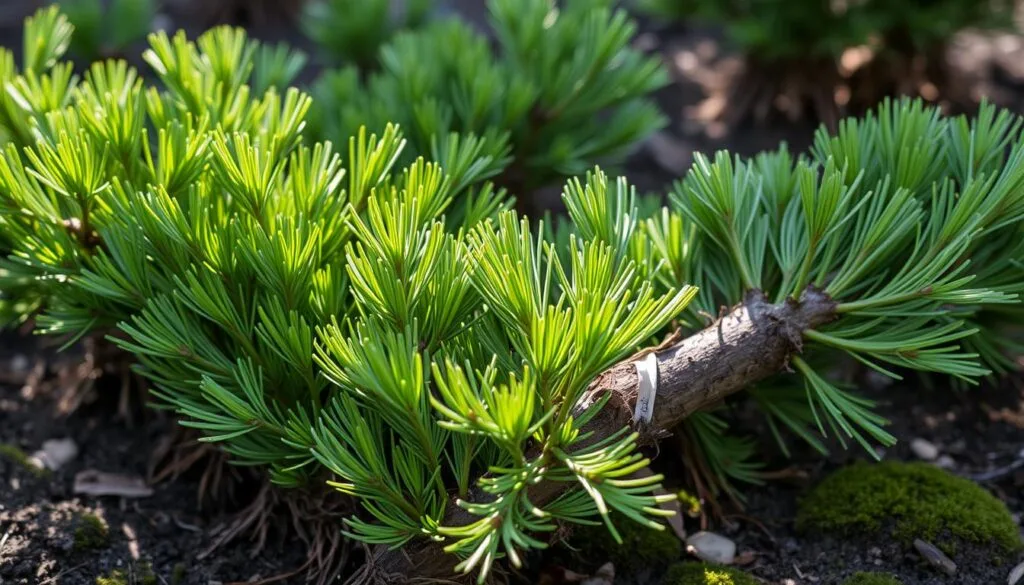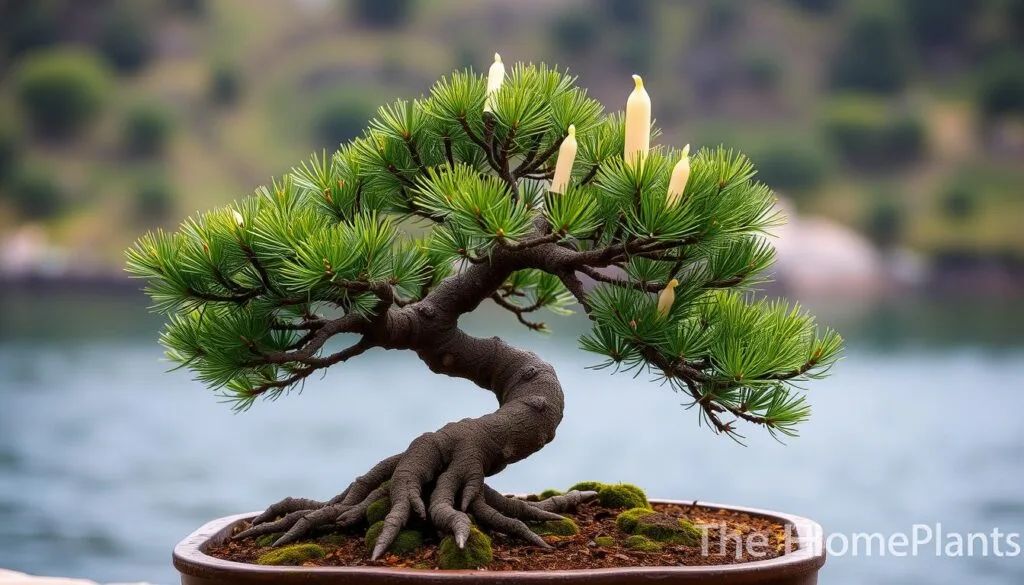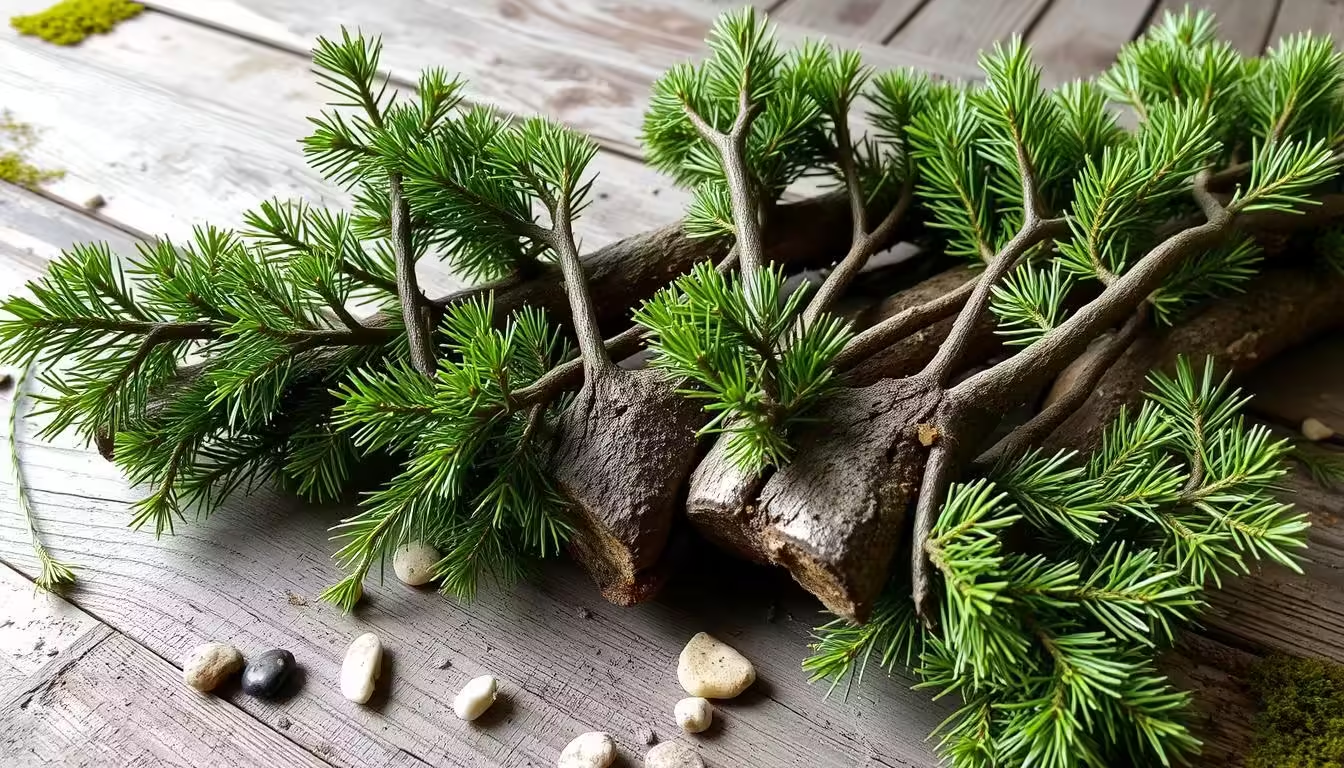I’ve always loved bonsai trees, and the Japanese black pine is one of my favorites. It has unique needles and branches that grow in a special way. Growing these pines from their new growth, or candles, is both fun and tricky. But with the right steps, you can propagate a beautiful Japanese black pine candles from cuttings.
Key Takeaways
- Japanese black pine (Pinus thunbergii) is a popular choice for bonsai enthusiasts, known for its unique growth habits and adaptability to various soil types.
- Propagating Japanese black pine from cuttings requires selecting the right candles, preparing the growing medium, and providing optimal care for the developing cuttings.
- By mastering the art of propagating Japanese black pine from cuttings, you can create your own unique bonsai specimens and expand your collection with ease.
- Proper techniques for taking cuttings, planting, and maintaining the propagated cuttings are essential for successful Japanese black pine propagation.
- Understanding the specific growth requirements and care needs of Japanese black pine cuttings will ensure your propagation efforts are fruitful and rewarding.
Introduction to Japanese Black Pine
Japanese black pine, known scientifically as Pinus thunbergii, is an evergreen tree from Japan’s coastal areas. It’s known for its unique look, with a flat top and drooping branches. These features create a striking silhouette.
The tree’s long, dark green needles and new growth “candles” in spring add beauty. These “candles” are especially captivating, making the tree a natural wonder in any landscape.
About Japanese Black Pine
The japanese black pine can grow up to 30-80 feet tall. It’s a big and impressive tree for gardens or bonsai collections. Its natural shape and ability to be pruned make it perfect for bonsai.
It prefers well-drained, acidic to neutral soil and full sun. This helps it grow to its full potential.
Characteristics and Growth Habits
The japanese black pine stands out with its long, dark green needles. These needles add depth and texture to its leaves. In spring, it transforms with “candles” of new growth, appearing as striking white tips.
This unique feature, along with its flat top and irregular shape, makes it a standout. It’s a true marvel in the world of ornamental trees and bonsai.
“The japanese black pine is a true masterpiece of nature, with its captivating appearance and unparalleled adaptability to bonsai cultivation.”
Benefits of Propagating Japanese Black Pine Candles
Propagating Japanese black pine from cuttings has many benefits. It lets you reliably copy the parent plant’s good traits. This includes its shape, growth, and needle color. The new plants grow faster, so you can enjoy their beauty sooner.
For bonsai lovers, this method is key. It helps create new trees with the exact look you want. Bonsai is all about controlling tree growth, and cuttings are a vital tool.
Statistics show that cutting buds to two in early September leads to 2 candles next year. Then, you get 4 candles the year after. Also, leaving 6-12 pairs of needles per candle is best. They harden off by mid-November.
“Propagating Japanese black pine from cuttings allows you to reliably reproduce the desirable characteristics of the parent plant, ensuring a quicker path to maturity and greater control over the aesthetic qualities of your bonsai specimens.”
Using japanese black pine candle pruning, bonsai propagation from cuttings, and conifer cutting propagation unlocks your black pine candle cutting propagation potential. You can make stunning, unique bonsai pieces.
Preparing for Propagation
Before starting to propagate your Japanese black pine trees, you need to get ready. You must gather the right materials and pick the best candles (new growth shoots). This step is crucial for successfully rooting your cuttings and keeping your Japanese black pine seedlings healthy.
Materials Needed
Here’s what you’ll need to begin:
- Sharp, sterile pruning shears or scissors
- A well-draining, sterile rooting medium, like a mix of perlite and peat moss
- Rooting hormone powder to help roots grow
- Clean containers or trays for planting the cuttings
Selecting the Right Candles
Choose candles that are healthy and strong, at least 2-3 inches long. Stay away from candles that look damaged, diseased, or stressed. The healthier the starting material, the better your chances of a thriving Japanese black pine seedling.
“For every 100 cuttings I make, I have a 95% strike rate in propagation. That’s a pretty good success rate!”
Remember, the key to successful propagation is in the preparation. By getting the right materials and picking the best candles, you’re setting your Japanese black pine cuttings up for success.
Step-by-Step Guide to Propagating Japanese Black Pine Candles
Propagating Japanese black pine from cuttings is rewarding. It lets you grow new plants from your tree. Follow these steps to propagate your own Japanese black pine candles. Enjoy their charm in your garden or bonsai collection.
Taking Cuttings
Begin by picking the right candles from your Japanese black pine tree. Choose healthy, new growth candles that are 4-6 inches long. Use sharp, clean pruners to make a clean cut just below the base of the candle. Make sure you have a stem with a few sets of needles attached.
Preparing the Growing Medium
Make a well-draining growing medium by mixing perlite and peat moss in equal parts. Moisten it with water, but make sure it’s damp, not soaking wet. This medium will help the cuttings grow roots well.
Planting the Cuttings
Dip the cut end of the cutting into rooting hormone powder to help it grow roots. Then, plant the cutting upright in the growing medium, making sure it’s firmly in place. Water it well to settle the soil around the base.
With the right techniques and care, you can grow new Japanese black pine seedling cuttings and black pine cuttings. Start with the how to propagate japanese black pine candles from cuttings you’ve collected.

Caring for Propagated Japanese Black Pine Cuttings
After you’ve successfully grown your Japanese black pine cuttings, it’s important to give them the right care. This will help them grow strong and healthy. Here are some key steps to follow:
Watering and Humidity Requirements
Keep the area around your cuttings humid by covering them with a plastic bag or dome. Check the soil often to make sure it’s moist but not too wet. Too much water can cause root rot, so watch the soil closely.
Providing Optimal Growing Conditions
Put your cuttings in a spot with bright, indirect light. Keep the temperature between 65-75°F. Once they have strong roots, which usually takes 4-8 weeks, you can start to move them to drier conditions and more sunlight.
| Repot Frequency | Recommended Time |
|---|---|
| Older trees (15 years or more) | Repot every 3 to 5 years |
| Established trees (5 years or more) | Repot every 2 to 4 years |
| Young trees (under 5 years) | Repot every year or every other year |
By watching the watering, humidity, and growing conditions closely, you can help your how to propagate japanese black pine candles from cuttings and japanese black pine seedlings thrive.
“The key to successful propagation of Japanese black pine is providing the right environmental conditions and diligent care during the early stages of growth.”
how to propagate japanese black pine candles from cuttings
Common Propagation Techniques
There are many ways to multiply your Japanese black pine, not just cutting. Air layering involves cutting a branch and wrapping it in moist medium to grow roots. Grafting is another method where you attach a cutting to a rootstock to create a new plant.
These methods need skill and patience but can be very rewarding. They are great for those who love bonsai or gardening and want unique Japanese black pine trees.
Choosing the right technique is key to growing healthy Japanese black pine. Knowing how to propagate japanese black pine candles from cuttings and the specific needs of black pine bonsai propagation is important. This knowledge will help your plants thrive.
“The key to successful Japanese black pine propagation lies in paying attention to the details – from selecting the right cuttings to providing the optimal growing conditions.”
Exploring these specialized methods can help you get the most out of your Japanese black pine. You can build a diverse and thriving collection of these beautiful trees.
Transplanting and Repotting
As your Japanese black pine seedling cuttings grow, they’ll need a bigger home. When transplanting, handle the roots with care to prevent damage. If in containers, they’ll need repotting every few years to grow and get fresh soil.
A Japanese black pine named ‘Taihei’ was repotted last year. The author plans to do needle-pulling, pruning, and wiring this fall. Another Japanese black pine, ‘Hachi Gen’, was repotted this year, with half its needles removed.
Japanese black pine roots can quickly fuse, forming solid wood blocks. Removing a root usually doesn’t harm much of the root system. But, older trees might have strong roots tied to their branches, causing problems if removed.
Slip potting Japanese black pine in the summer might not help much. Pines take a couple of years to establish their roots. Trees in pots can suffer from poor fertilization, too little or too much water, pests, diseases, and more.
Newly bought Japanese black pine can be unhealthy due to past care and price. The graft on a Japanese black pine might not always be visible. But, the movement in the trunk can make it good for beginner projects like literati styling.
Troubleshooting Common Issues
Caring for your japanese black pine bonsai seedlings is rewarding but comes with challenges. As you grow your japanese black pine seedling from cuttings, watch out for common problems. Quick action can keep your bonsai trees healthy and strong.
Recognizing and Resolving Problems
Japanese black pine bonsai may face winter burn, causing needle discoloration and dieback. Protect your trees from harsh winters and provide shelter.
Fungal diseases like Annosus root rot and brown spot needle blight can harm japanese black pine seedlings. Look for signs of discoloration, wilting, or needle loss. Use fungicides to treat these issues.
Pests like cotton root rot and damping-off can also threaten your how to propagate japanese black pine candles from cuttings. Regularly check for insect damage or soil problems. Take action to remove pests or improve growing conditions.
By being proactive and quick to address problems, you can ensure your japanese black pine bonsai seedlings thrive. Remember, caring for your bonsai and watching for issues are crucial for success.

Pruning and Shaping Japanese Black Pine Bonsai
Pruning is key for keeping your Japanese black pine bonsai looking great. It involves pinching or cutting back new growth candles. This helps control the size and direction of branches. It also helps create the tree’s unique twisted trunk and branches.
The best time to de-candling double-flush pines is in June. Young trees need a high nitrogen feed from Spring to Autumn. This helps them grow strong. The timing for de-candling depends on the tree’s size.
Japanese White Pines should not be fed in Spring. Wait until June or early July to start fertilizing. September is the best time to needle-pluck single-flush pines. This encourages back-budding by removing old needles.
When shaping, remove upward shoots except for those needed for training. Leave side and down-facing shoots. It’s important to not shade lower branches with upper ones. Remove or redirect branches that cause shading.
| Pruning Technique | Recommended Timing | Benefits |
|---|---|---|
| De-candling double-flush pines | Early to mid-June | Encourages back-budding and controls branch size and direction |
| Needle-plucking single-flush pines | September | Induces back-budding by removing previous year’s needles |
| Pruning upward-growing shoots | Ongoing | Shapes the tree and prevents shading of lower branches |
Learning to prune and shape your Japanese black pine bonsai is rewarding. It allows you to create a beautiful, balanced tree. This tree showcases the natural beauty and character of this iconic species.
Propagation for Bonsai Enthusiasts
For those who love bonsai, growing Japanese black pine from cuttings has big benefits. Cuttings let you copy the good traits of the parent plant, like its shape and looks. This is key for making bonsai trees with certain shapes. Plus, cuttings grow faster than seedlings, so you can have bonsai trees sooner.
Advantages of Propagating for Bonsai
- Consistent reproduction of desired traits from the parent plant
- Ability to create bonsai with specific shapes and forms
- Faster maturation of propagated cuttings compared to seedlings
Japanese black pine and Japanese red pine grow two times a year, perfect for bonsai fans. Japanese white pine grows once a year, in spring, which is great for shaping bonsai.
To care for bonsai pine trees, you need to repot them every two to three years. Make sure to water them right and use soil that drains well. Fertilize during the growing season and prune to shape the tree.
| Propagation Technique | Success Rate | Time to Maturity |
|---|---|---|
| Cuttings | 95% | Faster than seedlings |
| Seedlings | N/A | Slower than cuttings |
Using bonsai propagation from cuttings helps enthusiasts make beautiful Japanese black pine bonsai trees faster. This lets them dive into bonsai art more quickly and precisely.
Conclusion
Propagating Japanese black pine from cuttings is a fun and rewarding task. It lets you grow new plants for your garden or bonsai collection. By following the steps in this article, you can grow strong pine seedlings into beautiful trees.
Whether you’re a bonsai expert or just starting, learning how to propagate japanese black pine candles from cuttings is exciting. It opens up new ways to create unique and beautiful plant displays.
The pine propagation techniques we talked about are crucial for success. They include picking the right candles, preparing the soil, and giving them the best care. Knowing how Japanese black pine grows helps you make the right choices, leading to healthy black pine bonsai propagation.
Keep being patient and careful as you grow your Japanese black pine. With the right knowledge and effort, your cuttings will become stunning bonsai. They will be the highlight of your collection for many years.
FAQ
What are the benefits of propagating Japanese black pine from cuttings?
What materials do I need to propagate Japanese black pine from cuttings?
How do I select the right candles (new growth shoots) for propagation?
What are the steps for propagating Japanese black pine from cuttings?
How do I care for the propagated Japanese black pine cuttings?
What other propagation techniques can be used for Japanese black pine?
How do I properly prune and shape Japanese black pine bonsai?
What are the advantages of propagating Japanese black pine for bonsai enthusiasts?
Want To Learn More, Check Out These Links:
- Japanese Black Pine: Plant Care & Growing Guide
- Japanese Black Pines – Nebari Bonsai
- Chinese Indoor Plants: Adding Tranquility and Elegance to Your Home
- The middle stages of pine development – my favorite! – Bonsai Tonight
- Japanese black pine seed programing
- Pinus radiata – Nichigo Bonsai
- Late Fall Black Pine Maintenance – Prairie State Bonsai Society
- 7 Types of Bonsai Trees That Are Perfect for Beginners
- Conifer – Bonsai Workshop
- How to Propagate Bonsai & Make Cuttings | Bonsai Tutorials
- Large Japanese Black Pine Bonsai
- ✂️ How and When Should I Cut Back My Japanese Black Pine?
- Bonsai Pine Tree Care Guide
- How to Grow Japanese Aralia (Fatsia Japonica) | Gardener’s Path
- Cross-over root advice
- Why Are My Japanese Black Pine Leaves Droopy? 😔
- Pine Tree Diseases and How to Treat Them
- Australian Bonsai Gallery – News Articles
- How To Care For Pine Bonsai
- 20 Exquisite Japanese Tea Houses and Gardens to Experience in North America

